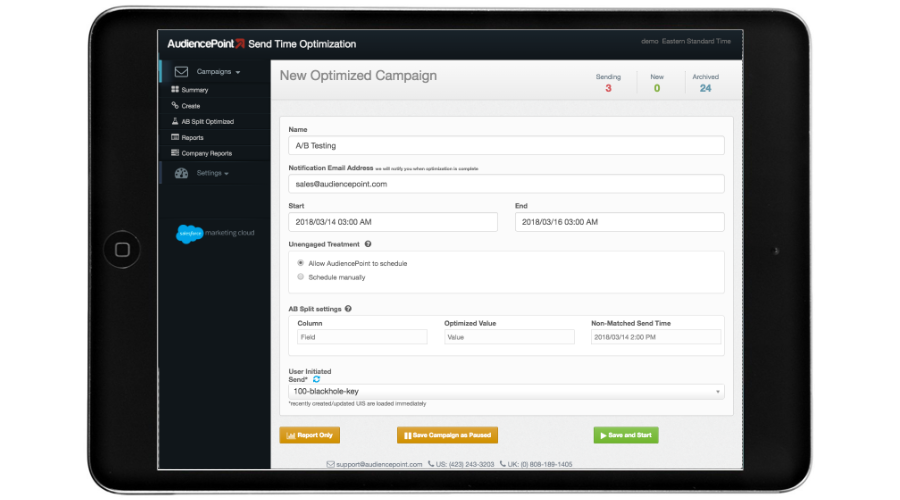AudiencePoint is thrilled to announce our new integration with Klaviyo! AudiencePoint is looking for partners to pilot our...
If you’ve been researching how to improve your email marketing campaigns, you’ve likely heard that KPIs for email marketing are important. This article will cover what you need to know about email engagement KPIs, which ones you should track, and how to track them.
What Are the Different Types of Key Performance Indicators?
There are different categories that you can use to organize KPIs for email marketing. Organizing KPIs into categories will help you use them effectively to improve different areas of your emails based on your goals.
What Are the 3 Types of KPIs?
The three main types of email KPIs are:
- Sales KPIs
- Growth KPIs
- Consumer engagement KPIs
All three of these types of KPIs can be essential for businesses looking to improve their email marketing performance. The next sections will break down each category in more detail.
Sales KPIs for Email
Sales KPIs for email marketing often track a company’s main objective, which is to generate more revenue and do it more efficiently. Common sales KPIs for email marketing are:
- Return on investment (ROI).
- Total direct sales from email.
- Average sales revenue per email.
- Average sales revenue per subscriber.
Each of these metrics will help a company effectively measure how email content directly translates into sales dollars. Many companies will be surprised by the great impact implementing effective email strategies will have on their sales numbers, so this can be a great proof of success.
Growth KPIs for Email
Growth KPIs measure the growth of your email list. These are effective measurements of how well your efforts to grow your list of email subscribers are working, along with how well your content is performing to keep subscribers on your list and engaged with your content. Common email growth KPIs are:
- Number of new subscribers.
- Total email subscribers.
- List growth rate.
- Unsubscribe rate.
By tracking each of these metrics, you’ll have a good baseline on how your email list is growing over time.
Consumer Engagement KPIs for Email
Every company should also be aware of consumer engagement KPIs for email marketing. Consumer engagement will track how your subscribers are reacting and responding to the content you send them. A highly engaged email list goes a long way toward long-term email marketing success. Common engagement metrics are:
- Open rate
- Click-through rate
- Click-to-open rate
- Conversion rate
- Email read time
- Email forwards/shares
Measuring these KPIs will give you a good baseline for consumer engagement and indications of any areas of your email content that could be more engaging.
What Are the Most Important KPIs for Email Marketing?
Now that you know the three main types of KPIs, you’re probably wondering which specific KPIs are most important to track for email marketing. The five most important KPIs are:
- Conversion rate: Email conversions measure targeted actions you would like subscribers to take, such as making a purchase or filling out a form. Conversion rate is the percentage of recipients that convert from the total emails delivered.
- Click-through rate: Email click-throughs measure link clicks within the email content. The click-through rate is the percentage of recipients that click a link within an email’s content from the total emails delivered.
- Open rate: Email opens are important to measure how many subscribers actually open your email content when they see it in their inbox. Open rate tracks the percentage of opens from the total emails delivered. However, Apple MPP has affected how open rate is tracked, so you must ensure you exclude Apple MPP opens to get accurate metrics.
- Bounce rate: Email bounces occur when your email isn’t accepted by the receiving domain. It is calculated by taking the percentage of emails that bounce from the total emails sent. Low engagement for a long time can cause emails to start bouncing, so ensuring subscribers stay engaged is important.
- Unsubscribe rate: Unsubscribes are when someone requests to be removed from your email list. They are calculated by taking the percentage of unsubscribes from the total emails sent. It’s an essential metric to track, since you want subscribers to be satisfied with your content.
Tracking each of these five key metrics will provide you with a good overview of how your emails are performing.
What Are the Best Ways to Track Email Performance?
The best way to track KPIs for email marketing is to use an email analytics tool. There are many analytics tracking options on the market. Most email service providers will provide some sort of tracking, so start with your ESP before integrating a secondary service if needed.
Can You Track Email KPIs Manually?
For some KPIs, you may be able to use some basic software to gather data and track it manually in a spreadsheet. However, this is far from the best or most efficient way to use email KPIs. Using an analytics tool will give you much more assistance in optimizing your campaigns.
How AudiencePoint Can Help with Your Email Marketing Strategy
If you’re looking to take the hassle and guesswork out of email marketing, AudiencePoint is the answer. AudiencePoint’s insight software will help you track crucial data and organize it in a streamlined way. This will give you actionable insights into how you can improve your marketing emails.
Through AudiencePoint, you will get insights into which subscribers on your list have become inactive, how to create effective re-engagement campaigns, how you can accurately segment your email list, and ways to make your content more engaging.
If you would like to get all these email marketing benefits, you can contact us to learn more about getting started with AudiencePoint today.





